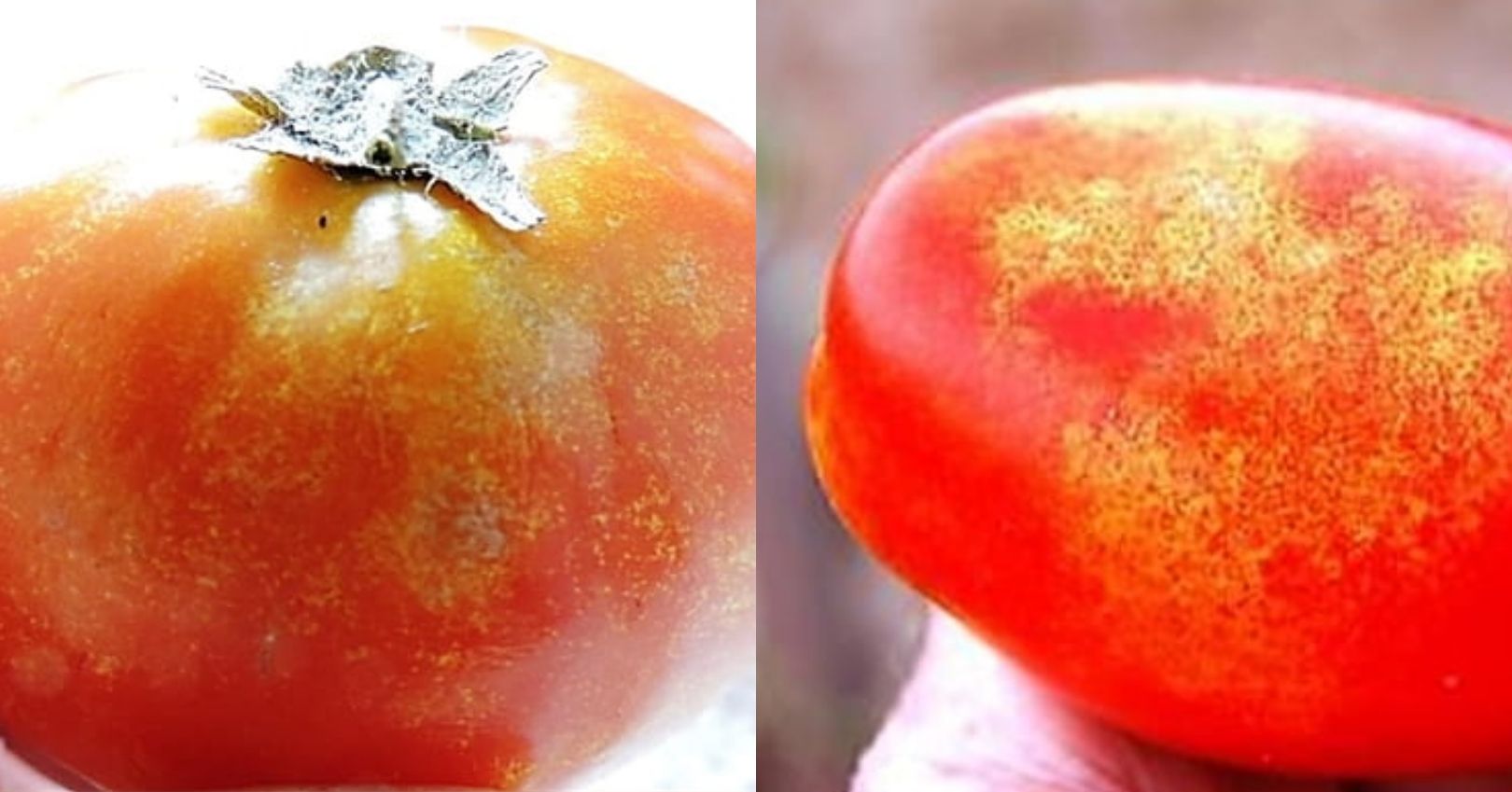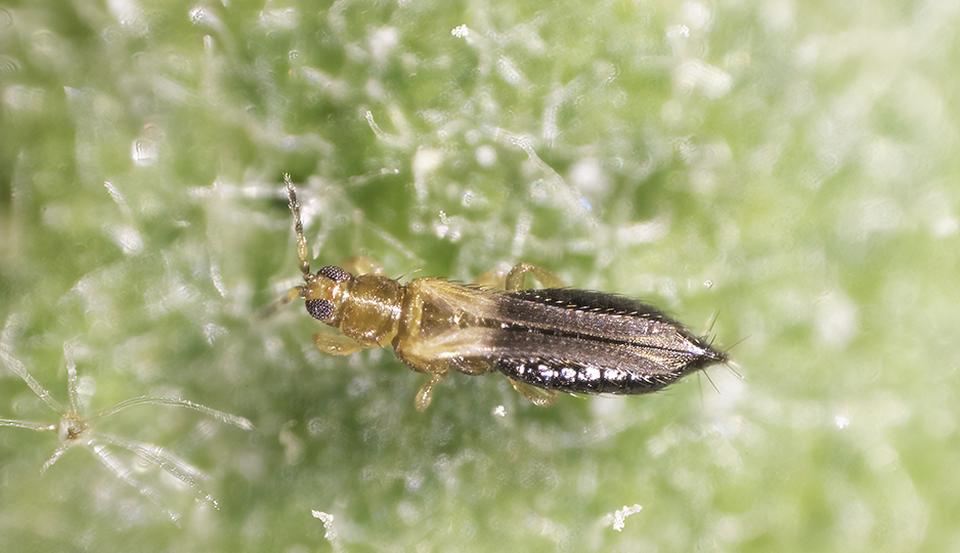
Thrips
Frankliniella Occidentalis
Pathogène :
Insect
Type:
Risque:
HIGH
Trips


QUI EN EST LA CAUSE ?
Frankliniella occidentalis, commonly known as the western flower thrips, is a small insect belonging to the family Thripidae. This pathogen is an insect with an elongated, narrow body, generally pale yellow to brown in color. Its life cycle includes egg, larva, pupa and adult stages. Females lay eggs in plant tissue. The larvae emerge and begin to feed on plant cells, causing direct damage. After passing through two larval stages, the larvae fall to the ground or take refuge in the plant to pupate. Finally, adults emerge and continue the cycle, reproducing rapidly under favorable conditions. This rapid life cycle and its ability to reproduce in various climatic conditions contribute to the difficulty of controlling it.
SYMPTÔMES
The disease caused by Frankliniella occidentalis in tomatoes manifests itself through several symptoms that affect both the quality and quantity of the harvested product. Damage is mainly mechanical due to feeding by larvae and adults, but also includes the transmission of plant viruses, such as Tomato wilt virus (TSWV). The feeding of these thrips causes the destruction of plant cells and the deformation of tissues.
- Presence of silver scars on leaves and fruits
- Deformation and necrosis of tender shoots
- Reduction of plant growth
- Black Taches (excrement) on the surface of the leaves
- Loss of general vigor of the plant
- Virus transmission that causes ring Taches and chlorosis
- Malformation and fruit drop


TEMPÉRATURE ET HUMIDITÉ
20-30°C
50-80%
VOIES DE TRANSMISSION
Direct contact with infested plants, wind, soil movements, contaminated tools, transportation of infested fruits
Do you want to remove this pest? Choose how you want to treat it.
TRAITEMENTS
Traitements chimiques
• ABAMECTIN 0.0015% + PYRETHRINS 0.02% [AL] P/V
• RAPE OIL 1.53% [AL] P/V
• RAPE OIL 848.24 g/l [EC] P/V
• ORANGE OIL 6% [SL] P/V
• ORANGE OIL 60g/L [ME] P/S
• PARAFFIN OIL (CAS [64742-46-7]) 79% [EC] P/V
• PARAFFIN OIL (CAS [8042-47-5]) 54.6% [EW] P/V
• ACETAMIPRID 0.005% [AL] P/V
• AZADIRACTIN 1% (AS AZADIRACTIN A) [EC] P/V
• Azadirachtin 2.6% (AS AZADIRACTIN A) [EC] P/V
• CYPERMETHRIN 10% [EC] P/V
• CYPERMETHRIN 5% [EC] P/V
• CYANTRANILIPROL 10% + ACIBENZOLAR-S-METHYL 1.25% [SC] P/V
• CYANTRANILIPROL 20% [SC] P/V
• DELTAMETHRIN 1.5% [EW] P/V
• DELTAMETHRIN 1.57% [SC] P/V
• DELTAMETHRIN 10% [EC] P/V
• DELTAMETHRIN 2.5% [EC] P/V
• DELTAMETHRIN 2.5% [EW] P/V
• FORMETANATE 50% [SP] P/P
• FORMETHANATE 9% (HYDROCHLORIDE) [SP] P/P
• LAMBDA CYHALOTHRIN 0.0015% [ME] P/V
• LAMBDA CYHALOTHRIN 1.5% [CS] P/V
• LAMBDA CYHALOTHRIN 10% [CS] P/V
• LAMBDA CYHALOTHRIN 5% [EG] P/P
• TERPENOID MIXTURE QRD 460 15.23% [EC] P/V
• PYRETHRINS 0.12% [AE] P/P
• PYRETHRINS 1.9% [EC] P/V
• PYRETHRINS 4.65% (as pyrethrum extract) [EC] P/V
• PYRETHRINS 4% (PYRETHHRINE EXTR.) [EC] P/V
• PYRETHRINS 5% [SC] P/V
• POTASSIUM SALTS OF FATTY ACIDS C14-C20 48% [EW] P/V
• POTASSIUM SALTS OF VEGETABLE FATTY ACIDS 13.04% [SL] P/V
• SPINETORAM 2.5% [SC] P/V
• SPINOSAD 12% [SC] P/V
• SPINOSAD 2.4% [SC] P/V
• SPINOSAD 48% [SC] P/V
• SPIROTETRAMAT 10% [SC] P/V
• SPIROTETRAMAT 15% [OD] P/V
Traitements autorisés en agriculture biologique
• RAPE OIL 1.53% [AL] P/V
• RAPE OIL 848.24 g/l [EC] P/V
• ORANGE OIL 6% [SL] P/V
• ORANGE OIL 60g/L [ME] P/S
• PARAFFIN OIL (CAS [64742-46-7]) 79% [EC] P/V
• PARAFFIN OIL (CAS [8042-47-5]) 54.6% [EW] P/V
• AZADIRACTIN 1% (AS AZADIRACTIN A) [EC] P/V
• Azadirachtin 2.6% (AS AZADIRACTIN A) [EC] P/V
• LAMBDA CYHALOTHRIN 0.0015% [ME] P/V
• LAMBDA CYHALOTHRIN 1.5% [CS] P/V
• LAMBDA CYHALOTHRIN 10% [CS] P/V
• LAMBDA CYHALOTHRIN 5% [EG] P/P
• PYRETHRINS 0.12% [AE] P/P
• PYRETHRINS 1.9% [EC] P/V
• PYRETHRINS 4.65% (as pyrethrum extract) [EC] P/V
• PYRETHRINS 4% (PYRETHHRINE EXTR.) [EC] P/V
• PYRETHRINS 5% [SC] P/V
• POTASSIUM SALTS OF FATTY ACIDS C14-C20 48% [EW] P/V
• POTASSIUM SALTS OF VEGETABLE FATTY ACIDS 13.04% [SL] P/V
• SPINOSAD 12% [SC] P/V
• SPINOSAD 2.4% [SC] P/V
• SPINOSAD 48% [SC] P/V
Traitements biologiques
• AMBLYDROMALUS LIMONICUS (Parasitoid and predatory mites)
• AMBLYSEIUS SWIRSKII (Parasitoid and predatory mites)
• BEAUVERIA BASSIANA (STRAIN ATCC 74040) 2.3% (2.3X10E7 VIABLE SPORES/ML) [OD] P/V
• BEAUVERIA BASSIANA (GHA STRAIN) 22% (4.4 x 10E10 CONIDIAS/G) [WP] P/P
• BEAUVERIA BASSIANA strain PPRI 5339 8% (8 X 10E12 CFU/L) [OD] P/P
• CHRYSOPERLA CARNEA (Parasitoid and predatory insects)
• HETERORHABDITIS BACTERIOPHORA (Parasitoid and predatory nematodes)
• MACROCHELES ROBUSTULUS (Parasitoid and predatory mites)
• MACROLOPHUS PYGMAEUS (Parasitoid and predatory insects)
• METARHIZIUM BRUNNEUM strain Ma 43 10.5% [OD] P/V
• NEOSEIULUS CUCUMERIS (Parasitoid and predatory mites)
• ORIUS LAEVIGATUS (Parasitoid and predatory insects)
• PAECILOMYCES FUMOSOROSEUS (STRAIN FE 9901) 18% (2 X 10 E9 CFU/G) [WP] P/P
• STEINERNEMA FELTIAE (Parasitoid and predatory nematodes)
• TRANSEIUS MONTDORIENSIS (Parasitoid and predatory mites)
Recommandations
- Implement regular monitoring using blue sticky traps to detect the presence of thrips.
- Use mesh covers in greenhouses to prevent the entry of thrips.
- Maintain good crop hygiene by eliminating remains of affected plants and fruits.
- Carry out crop rotations to reduce pest pressure.
- Introduce and conserve natural enemies such as predatory mites and parasitoid wasps.
- Apply treatments with specific insecticides in a preventive and rotating manner to avoid resistance.
- Use horticultural oils and insecticidal soaps as complementary control methods.
- Implement integrated pest management (IPM) practices to reduce dependence on chemicals.
Enlace patrocinado
Enlace patrocinado
Enlace patrocinado
Enlace patrocinado
Enlace patrocinado
Enlace patrocinado
Effective against all types of fungi
TRAITEMENTS
Remèdes maison
There are no home treatments
Alliés naturels
Traitements chimiques
There are no treatments for this disease. Treatments are directed at the insect vectors that transmit it. See insect treatments.
RECOMMANDATIONS
- Check the back of the leaves frequently, especially in dry weather.
- Spray water on the leaves to increase humidity and prevent them from settling.
- Keep plants healthy with good watering and adequate light.
- If you see cobwebs or damage, clean the leaves with a damp cloth or pressurized water.
- Use potassium soap or neem oil every few days until they disappear.
Plantes répulsives
Rosemary, Dill, Coriander
PRODUITS RECOMMANDÉS
Enlace patrocinado
Enlace patrocinado
Enlace patrocinado
Enlace patrocinado
Enlace patrocinado
Enlace patrocinado
Effective against all types of fungi
*Les traitements recommandés sont des recommandations basées sur les bases de données des autorités et ne remplacent en aucun cas les lignes directrices établies par la législation de chaque pays.
*Les produits présentés sont des recommandations et ne sont pas nos propres produits. En tant qu'associés Amazon, nous gagnons des revenus grâce aux achats de produits recommandés.




















